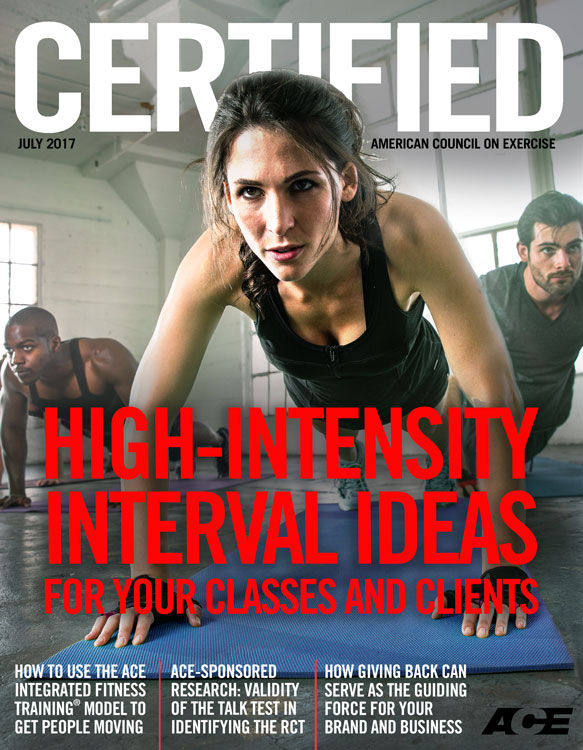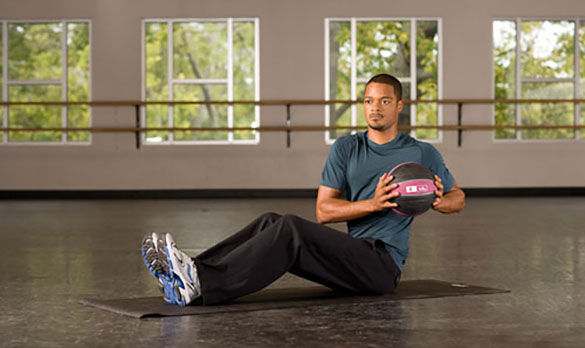
The ACE Integrated Fitness Training® (ACE IFT®) Model is the centerpiece of the ACE Personal Trainer Manual and a featured element of each of our books. From beginning exercisers to elite-level athletes, the ACE IFT Model provides an innovative and systematic approach to achieving lasting results. In this new series, we offer practical tips for using the ACE IFT Model with different client populations, along with workouts you can put into immediate practice.
In this article, we explore how to use the ACE Integrated Fitness Training® (ACE IFT®) Model to achieve ACE’s mission to “Get People Moving.” In other words, how do you use the Model when working with a previously sedentary client who is looking to establish an exercise habit and find a way to get healthy? This is not about achieving a lofty performance goal or integrating high-intensity interval training into an already established routine. Rather, it’s about inspiring clients or potential clients, those who may be teetering on the edge between starting an exercise program and abandoning the mission, and helping them get started on the road to better overall function and health.
The foundation of the ACE IFT Model is built upon rapport. The importance of those first sessions cannot be overstated in terms of establishing a bond and a sense of trust with a new client. As explained by Todd Galati, M.A., ACE’s Senior Director of Science and Research, the goal at this initial stage is to help the client identify and then strategize ways to overcome what has prevented him or her from being physically active in the past.
“The key,” says Galati, “is to find out where each client is in terms of individual goals and hurdles. Then, you can build a program that matches the client both physically and emotionally.”
How to Build Rapport
Three attributes are essential to the establishment and maintenance of successful client–trainer relationships. What makes rapport unique is that it is an ongoing process, which means that health and fitness professionals must always be mindful of the following attributes, regardless of how well they feel they know a client or how strong a bond might be.
- Empathy is the ability to experience another person’s world as if it were one’s own.
- Warmth involves an unconditional respect for another person that offers acceptance, regardless of his or her individuality or uniqueness.
- Genuineness is the ability to be honest and open.
Empathy is one of the most important skills for health and fitness professionals, particularly when working with clients who are struggling to overcome barriers that may have been holding them back for years. To develop empathy, you can:
- Be attentive, separating superfluous information from the client’s core message.
- Be conscious of how cultural and ethnic differences affect communication.
- Distinguish between factual messages and those composed of feelings and emotions, which often are expressed via nonverbal communication.
- Be aware of how a client’s emotional patterns change based on the topic being discussed, such as weight gain or declining health.
Being empathetic to a client’s struggle better positions you to understand his or her mindset and facilitate ongoing behavior change.
Conducting Assessments
While the collection of health-history information is essential for determining the need for medical clearance, the majority of physical and anthropometric assessments are not necessary with this population. Imagine yourself as an unfit and inactive individual struggling with overweight, obesity or the performance of basic activities of daily living. Do you really need confirmation of what you already know? Keep this in mind when selecting assessments (if you choose to do any at all), as body-fat percentages, circumference measures and tests of physical ability are far more likely to be demotivating at this stage than educational or even useful.
Instead of conducting a formal set of assessments, Galati recommends getting a new client moving right away. “You can start with some light cardiorespiratory exercise and use the talk test—without informing the client that you are doing so—to determine what constitutes moderate intensity for that client. Doing this informally,” he explains, “removes the intimidation factor.”
In addition, you can takes notes on how long the client lasts during that initial session on a particular machine or at a certain speed or intensity. Be sure to celebrate any improvements you observe during the early sessions with a new client: “Remember on day 1, when you had to take a break after six minutes on the elliptical machine? Well, you just did 12 minutes at that same intensity. You doubled your cardio fitness in just a couple of weeks!”
Pete McCall, M.S., faculty in the Exercise Science Department at Mesa College and ACE Certified Personal Trainer, concurs with Galati’s advice. “It’s essential that newcomers learn that exercise doesn’t have to be hard, and it doesn’t need to be painful or punitive to work,” says McCall, “and a full session of formal assessments can make it appear that way.” Instead, he suggests that, in addition to observing a client’s ability to perform moderate-intensity cardio exercise, you have him or her perform some low-intensity body-weight exercises, such as planks, glute exercises or balance tasks. Record how many repetitions the client was able to perform with proper form and celebrate improvements in this area as well.
McCall offers one more tip: Check in fairly often during workouts to ask how something feels on a scale of 1 to 10 and record the responses. That way, you can remind the client of how much more difficult certain movements or workouts felt just a few weeks earlier: “Remember how much you used to struggle with planks? Look at you now!”
These early successes can create much-needed momentum for someone trying to establish an exercise habit. Your role early on, McCall reminds us, is to help the client be consistent and have fun. With this in mind, it’s a good idea to minimize soreness as much as possible, as many new exercisers use discomfort as one more reason to skip a workout. Gains in strength, endurance or flexibility are not nearly as important early on as the establishment of a positive relationship with physical activity.
Cardiorespiratory Exercise
Most previously sedentary individuals are going to begin in Phase 1: Aerobic-base Training of the cardiorespiratory training component of the ACE IFT Model. The goal is to establish baseline aerobic fitness to improve health so that the client can later build on this base to enhance his or her endurance, energy levels, mood and caloric expenditure during workouts. Exercise in this phase should be performed at steady-state intensities in the low-to-moderate range. This means exercising at or below the first ventilatory threshold, which can be determined using the informal talk test described earlier.
Regardless of how long a new client is able to perform aerobic exercise—some previously sedentary clients will struggle to exercise for more than a few minutes at a time—the goal is to gradually increase frequency and duration until he or she is exercising for 20 to 30 minutes, three to five days per week.
Remind clients that doing cardio exercise is not about becoming an athlete or running a half-marathon someday, but rather, as Galati expresses it, “making it easier to do the things you love, and to do them for longer periods of time.” Identifying the experiences a client most values can help you establish appropriate goals and then develop programs that enhance his or her ability to participate in, and enjoy, those experiences.
Phase 2 of the cardiorespiratory training component of the ACE IFT Model is Aerobic Efficiency Training. This phase is dedicated to enhancing a client’s aerobic efficiency by increasing the duration of sessions, increasing the frequency of sessions and, when appropriate, introducing intervals, which will help alleviate boredom. It is important to note that many clients will train in Phase 2 for many years, as their goals do not require the high levels of cardiorespiratory fitness required to move on to Phase 3.
Functional Movement and Resistance Training
Previously sedentary individuals are likely best suited for Phase 1: Stability and Mobility Training, though some may be able to progress to performing Phase 2 movements relatively quickly. Conversations during early sessions should center on posture and quality of movement. Many clients, especially those with little experience in a fitness or athletic setting, will think that lifting weights is a starting point rather than a form of training that is only suitable after the establishment of proper stability and mobility.
“The various elements of proper movement and posture,” explains Galati, “are all improved through human movement, whether a client’s goal is to play with her kids or grandkids, dance with her husband or garden on the weekends.”
Phase 1: Stability and Mobility Workout
Sabrena Jo, M.S., Senior Exercise Scientist at ACE, created two exercise series that are appropriate for clients in Phase 1. For each of the following exercises, have clients perform five repetitions, holding each for 10 seconds:
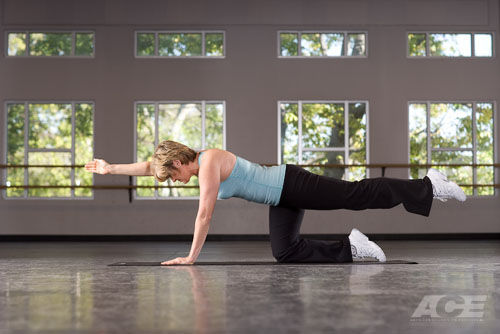

Have clients hold each of the following stretches for 60 seconds:
Phase 2: Movement Training is focused on training movement patterns through programming that builds on what the client did in Phase 1. The key is to help clients develop stability and mobility throughout the kinetic chain without allowing one to compromise the other (that is, don’t develop mobility at the expense of stability or vice versa). Movement training focuses on five primary movements:
- Bend-and-lift movements (e.g., squatting)
- Single-leg movements (e.g., lunging)
- Pushing movements (e.g., pushing open a door)
- Pulling movements (e.g., opening a car door)
- Rotational movements (e.g., picking up an object on the left and placing it on the right)
Training clients to improve their performance of these five movements can greatly enhance their ability to perform activities of daily living and subsequently enhance their overall quality of life. Newcomers to the gym do not need to focus on lifting heavier weights or performing complex movements. Rather, they should be doing exercises that directly translate to tasks they perform and find essential in their daily lives, whether that involves lifting and playing with their grandchildren, climbing the stairs to their second-floor apartment or carrying groceries in from the car.
Phase 2: Movement Training Workout
Have clients perform 10 repetitions of each of the exercises in this routine, which was again created by Sabrena Jo, progressing only when they have mastered the primary exercises.
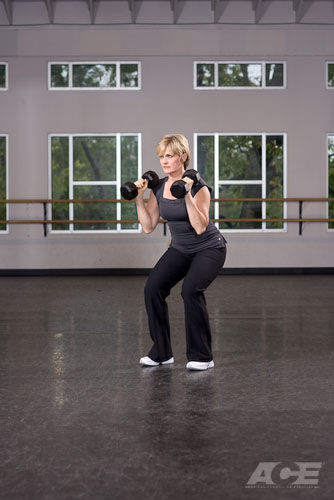
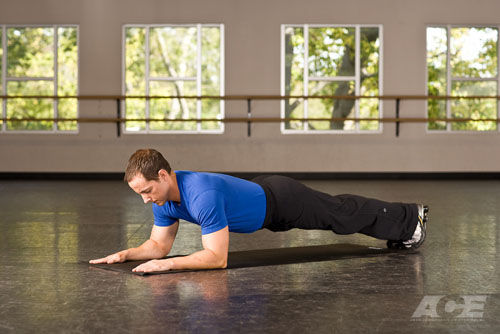
When to Progress from Phase 1 to Phase 2 and Beyond
When to progress a client is a topic with which many health and fitness professionals struggle. A basic misunderstanding may underlie the difficulty many coaches and trainers feel. According to Pete McCall, there is no hard line between phases. “The phases of the ACE IFT Model are a means of classifying the intensity of exercise,” he says, “not a method to classify the clients themselves.” In other words, there is no such thing as a “Phase 1 client.” Instead, there is an individual performing a Phase 1 movement.
The decision about whether to progress should be made on an exercise-by-exercise basis, and most clients will be performing exercises in multiple phases during a single workout. “Variety is what makes it fun,” McCall reminds us. He recommends introducing new loads and forces to tissues, but at low volumes at first. “Use light weights, or have a client perform box jumps onto an aerobic step,” he says. “Remember, though, there should be less of a focus on increasing intensity and more focus placed on adherence and enjoyment.”
In Conclusion
“Exercise doesn’t have be earth-shattering to be productive,” says Galati. It’s about good movement done on a routine basis.” By keeping the focus on consistency and fun, health and fitness professionals can help previously sedentary individuals get moving in a way that increases their function, health and overall quality of life.





 by
by 